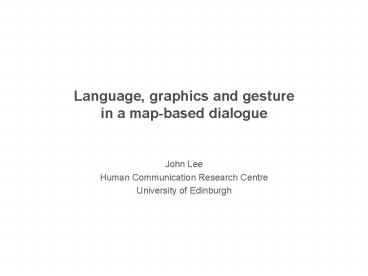Language, graphics and gesture in a mapbased dialogue - PowerPoint PPT Presentation
1 / 11
Title:
Language, graphics and gesture in a mapbased dialogue
Description:
Gesture and language are integrated parts of a multimodal ... use of deixis and ellipsis; high ... In remote, deixis being impossible, descriptive ... – PowerPoint PPT presentation
Number of Views:27
Avg rating:3.0/5.0
Title: Language, graphics and gesture in a mapbased dialogue
1
Language, graphics and gesture in a map-based
dialogue
- John Lee
- Human Communication Research Centre
- University of Edinburgh
2
Gesture and Languagethe emerging consensus?
- Gesture and language are integrated parts of a
multimodal communication system - Gesture is (typically) neither epiphenomenal,
redundant nor unrelated, but complementary - Information provided only in gesture is often
essential to understanding a communication - Both speakers and hearers are able to exploit
this (at least subconsciously) - A considerable literature on these points now
exists, cf. Goldin-Meadow, 2003.
3
Gesture and information
- Gesture naturally often conveys spatial
information - E.g. direction or nature of a movement mentioned
(but not described) in speech - Nature of gesture can depend on language
structure - Gesture can be of major assistance in explanation
- examples of kinship, fish traps etc. in Laos
(Enfield 2005) - which it achieves by allowing the use of
spatial structures as cognitive artifacts - But gesture in diagrammatic reasoning tasks is
not greatly studied
4
Our study
- Collaboration between Edinburgh and Stanford
(Jean Carletta, Tracy McLeod Barbara Tversky,
Julie Heiser) - Map-based task recovery of people from Stanford
campus after a hypothetical earthquake - Conducted in pairs video-recorded
- Two conditions co-present and remote
- Videotapes annotated using Noldus Observer and
NITE toolkit - Data analysis still in a fairly early stage
- emphasis here is on planning phase of the task
5
The map (or one like it)
6
The two conditions
7
Observations
- Theres a lot of gesture in the remote condition
- often more than in co-present, unexpectedly
(Alibali et al 2001) - which perhaps emphasises that even co-present
is not face-to-face - Very tight focus of interaction on the map itself
- Absence of iconic gestures and beat gestures
- (in both conditions)
- If beat gestures are perhaps fundamental
elsewhere, deictic and focussing gestures may
be in our situation
8
Observations (contd.)
- In co-present, gesture without speech is unusual
- except when continuing with an action already
discussed - as though unexplained gesture would be
inappropriate - and so is speech without gesture
- heavy use of deixis and ellipsis high
multimodality - Results in a powerful imperative to interact
- produces a close and explicit focus on
information - produces a faster and much more successful
performance on the task than in remote (cf.
Heiser et al 2004) - Clear benefit of shared access to the map,
mediated by shared gesture
9
Observations (contd.)
- In remote, deixis being impossible, descriptive
phrases are frequent - Conventions need to be agreed for identification
- e.g. place names, people numbers, etc.
- Task progress is slowed
- Lack of fine-grained feedback leads to poor
convergence - sketches in final stage are low quality (Heiser
et al 2004) - cf. MAGIC results
10
Speculation
- Role of gesture in betraying processes of thought
(cf. Goldin-Meadow 2003) is important - evident in remote in absence of speech probably
also a factor in co-present - but hard to disentangle from communication
- Grounding is an important process with 2 levels
- linguistic (cf. Clark) to establish shared
reference - reasoning to ensure shared strategy and allow
confident progress based on mutual contributions - both levels more difficult to achieve in remote
condition - Continuity between use of ephemeral gestural
cognitive artifacts (Enfield) and concrete
diagrams
11
Moral for technology?
- In systems to support distant task
collaborationtry to reproduce co-presence! - Hardly a new idea
- But maybe some thoughts here about focusing
multimodality on areas such as gesture around
task representations, rather than e.g.
reproducing the face-to-face experience































